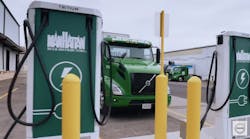For a major beer transporter in the New York metropolitan area, Manhattan Beer Distributors (MBD), making the move to electric mobility is the next logical step—since the company’s fleet was among the first in the Northeast to go green starting 13 years ago with compressed natural gas (CNG).
Bronx, New York-based MBD ranks as the fourth largest beer distributor in the U.S. with a fleet of 400 trucks, about 150 of which are now CNG, and the company has ordered five all-electric Volvo VNRs, the first of which was handed over during an Oct. 12 worldwide broadcast of a Volvo Trucks electromobility event, “The Leap: How to Go Electric.”
MBD “is known for their bold moves, and their care for sustainability,” Peter Voorhoeve, SVP of Volvo Trucks North America, said onsite at MBD headquarters during the broadcast. “They play an exemplary role in New York City, and we are very proud at Volvo Trucks to be partnering with them.”
“We’re motivated to lead in sustainable transport solutions for several reasons,” Mitchell Bergson, MBD’s chief transformation officer, said during the event. “Most importantly, it’s the right thing to do for our people, it’s the right thing to do for our business, and it’s the right thing to do for our communities. It’s in keeping with our values, and it’s really an extension of work we’ve done over the last two decades. We’re continuing that evolution, that transition now to electric vehicles.”
An early adoption strategy
Voorhoeve and Bergson said MBD is a fleet that is putting a spotlight on a strategy that all fleets—small like MBD’s and other much larger ones like Amazon’s and Ikea’s—also highlighted during the broadcast: early adoption. Get the charging infrastructure, some even financed by Volvo, in place as soon as possible, Bergson and representatives from Ikea and Amazon said during the broadcast.
The virtual event covered all aspects of making the move to electric mobility, starting with partnering with companies, local jurisdictions, and larger governments to put the necessary infrastructure in place.
Volvo itself wants 50% of its truck sales to be electric vehicles by 2030—and 100% by 2040, Jessica Sandström, SVP of product management and sustainability, said. Volvo Trucks posted a replay of the entire electromobility event.
Fleets such as MBD’s that cover 300 kilometers or less (or about 185 miles) are prime candidates for early adoption of electrification since they can build their own charging infrastructure within range of their deliveries and don’t have to depend on public stations, even though more and more are cropping up in Europe and North America, Sandström said.
She did warn it will be more expensive in the beginning for fleets to go electric. “But there are benefits to start early,” Sandström said.
She also covered more of Volvo’s overall electrification strategy. And other early adopters such as European logistics provider Det Forenede Dampskibs-Selskab (DFDS), which recently ordered 100 electric Volvos, were also highlighted. Volvo Trucks President Roger Alm personally delivered the first Volvo FM to the shipping and logistics company in Gothenburg, Sweden.
As just one part of its strategy and to support early-adopter fleets, Volvo has set up a separate business unit, Volvo Energy, to focus on batteries and charging infrastructure. That’s in addition, of course, to being a source for the EV trucks themselves. As another part of its strategy, Volvo will offer a short-term lease option, so fleets unsure of making the leap to electric can temporarily try out Volvo EVs.
For fleets such as DFDS, the truck maker also is providing financial services and even support for installation of the necessary EV charging infrastructure.
During the virtual event, Europe’s DFDS focused on strategies a local-regional fleet can adopt to effectively use electric vehicles. In its deliveries, DFDS mapped out staggered 120-kilometer runs (about 75 miles) so that multiple trucks could rest for charging while others are on the road.
This month, Volvo signed a deal with DFDS to deliver the 100 FMs, the largest commercial order of electric trucks for the truck maker so far. Volvo also wants to build its own charging network in Europe.




